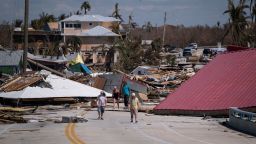Summer in the Northern Hemisphere is playing out like an apocalypse movie: a tale of heat, floods and fire. But scientists warn this may only be a preview of the unpredictable chaos to come if the world continues to pump out planet-heating pollution.
Just over halfway through July and already a slew of extreme weather records has been broken.
A prolonged, unrelenting heat wave has scorched large parts of the South and Southwest United States. Temperatures in Phoenix, Arizona, have hit at least 110 degrees Fahrenheit (43.3C) for a record-breaking 19 consecutive days, and emergency departments are flooded with heat-related illness.
Southern Europe is experiencing one of its most extreme heat waves on record, with wildfires raging in Greece, Spain and Switzerland. And in Asia, temperatures have pushed above 50 degrees Celsius (122 degrees Fahrenheit) in China, while parts of South Korea, Japan and northern India are experiencing deadly flooding.
In a statement on Tuesday, Petteri Taalas, secretary general of the World Meteorological Organization, called this relentless cascade of extreme weather “the new normal.”
But some scientists now baulk at that framing.
“When I hear it, I get a bit crazy because it’s not really the new normal,” said Hannah Cloke, a climate scientist and professor at the University of Reading in the UK. “Until we stop pumping greenhouse gases into the atmosphere we have no idea what the future looks like.”
She is one of many scientists who warn that, while this summer is very bad, it’s only just the beginning. As long as global temperature continues to rise, they said, the world should brace for escalating impacts.

Michael E. Mann, a climate scientist and distinguished professor at the University of Pennsylvania, prefers to describe the weather we are seeing as “the new abnormal.”
The new normal “wrongly conveys the idea that we’ve simply arrived in some new climate state and that we simply have to adapt to it,” he told CNN.
“But it’s much worse than that. The impacts become worse and worse as fossil fuel burning and warming continues. It’s a shifting baseline of ever-more devastating impacts as long as the Earth continues to warm.”
For scientists like Mann and Cloke, this year’s extreme weather has largely not been surprising. The development of El Niño, a natural phenomenon that has a global warming impact, layered on top of longterm, human-caused global warming, was expected to have a big impact.
But regionally, there have been “some remarkable anomalies,” said Mann, who pointed to record-low levels of winter sea ice in Antarctica and “off the charts” heat in the North Atlantic. “They are a reminder that we can not only expect to see records broken, but shattered, if we continue burning fossil fuels.”

As the climate crisis accelerates, the stage is set for more surprises.
“The weather extremes will continue to become more intense and our weather patterns could change in ways we yet can’t predict,” said Peter Stott, a science fellow in climate attribution, at the UK Met Office.
In some cases, the heat, fire and floods are already exceeding what climate models have predicted, Mann said. In part, this is due to changes in the jet stream, he said.
The jet stream is driven by the temperature difference between the poles and the equator. As the Arctic rapidly warms, that temperature difference reduces and the jet stream slows and weakens. This can mean that weather systems can get locked into place for prolonged periods.
“The same region gets baked day after day, or rained on day after day – just the sort of behavior we’re seeing this summer,” Mann said.
It will be hard for countries to adapt to these new extremes, said Vikki Thompson, a climate scientist at the Royal Netherlands Meteorological Institute. “We will see combinations of events that could lead to unexpected impacts. Extreme heat could be quickly followed by heavy rainfall impacting society, agriculture, and ecosystems in unusual ways,” she told CNN.
Countries tend to prepare for the worst they have experienced, but with climate extremes smashing current records, “we need to be prepared for situations that might currently appear impossible,” Thompson said.
While the world is already locked into some impacts of global warming, due to the global failure to cut planet-heating pollution, scientists are clear that there is still time to avert the worst consequences.
The latest science shows that global temperature rise would halt almost immediately after we stop burning fossil fuels, Mann said.
And this summer is more evidence that every fraction of a degree by which the world is able to limit global heating will count, Cloke told CNN. The planet is around 1.2 degrees Celsius warmer than it was before the industrial revolution – still short of the 1.5 degrees scientists are warning the planet should stay under. But even now, the consequences are deadly and far-reaching.
“It is really frightening,” she said. “But the more action that we take, the sooner that we take that action, the better our future will be.”
Read more:
Why nighttime heat can be so dangerous – and why it’s getting worse
Summer has become a survival test as heat gets more extreme
2023 could be the hottest year on record
"some" - Google News
July 19, 2023 at 06:01PM
https://ift.tt/ETI6tva
Is this extreme weather the ‘new normal?’ There’s no such thing, some scientists say - CNN
"some" - Google News
https://ift.tt/V58CUoD
Shoes Man Tutorial
Pos News Update
Meme Update
Korean Entertainment News
Japan News Update
Bagikan Berita Ini

















0 Response to "Is this extreme weather the ‘new normal?’ There’s no such thing, some scientists say - CNN"
Post a Comment